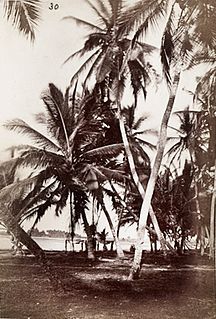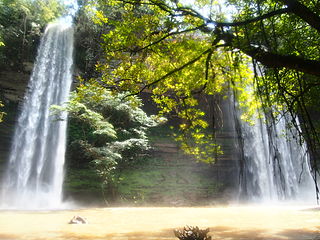
The Demography of Ghana describes the condition and overview of Ghana's population. This article is about the demographic features of the population of Ghana, including population density, ethnicity, education level, health of the populace, religious affiliations, and other aspects of the population.

Hodh Ech Chargui is a large region in eastern Mauritania, with an area of 182,700 km2. Its capital is Néma, but the largest town, in Bassiknou Department, is Fassala at the extreme southeast of Mauritania, with 65,927 inhabitants at the 2013 census. The region borders the Mauritanian regions of Adrar, Tagant and Hodh El Gharbi to the west and Mali to the east and south. The Aoukar basin, which formerly gave name to a greater region, is located in the western part of Hodh Ech Chargui.
The Dangbe language, also Dangbe or Adaŋgbi, is a Kwa language spoken in south-eastern Ghana by the Dangbe People (Dangbeli). The Dangbeli are part of the larger Ga-Dangbe ethnic group. Klogbi is a variant, spoken by the Kloli. Kropp Dakubu (1987) is the most thorough grammar of the language.

The Eastern Region is located in south Ghana and is one of the sixteen administrative regions of Ghana. Eastern region is bordered to the east by the Lake Volta, to the north by Bono East Region and Ashanti region, to the west by Ashanti region, to the south by Central region and Greater Accra Region. Akans are the dominant inhabitants and natives of Eastern region and Akan, Ewe, Krobo, Hausa and English are the main spoken languages. The capital town of Eastern Region is Koforidua.The Eastern region is the location of the Akosombo dam and the economy of the Eastern region is dominated by its high-capacity electricity generation. Eastern region covers an area of 19,323 square kilometres, which is about 8.1% of Ghana's total landform.

Koforidua, also popularly known as K-dua or Kofcity, is a city and the capital of Eastern Region in southern Ghana. Koforidua was founded in 1875 by migrants from Ashanti. It is also called New Juaben. The city has a settlement city proper population of 183,727 people as of 2010, Koforidua is an amalgamation of two Municipalities; New Juaben North and South. The city has a blend of colonial and modern architecture.

The Accra Metropolitan District is one of the 254 Metropolitan, Municipal and Districts in Ghana, and among the 26 such districts in the Greater Accra Region with a population of 284,124 as of 2021. As of March 2018, it spans an area of approximately 60 km2 (23 sq mi) and encompasses the Ablekuma South, Ashiedu Keteke, and Okaikoi South sub-metropolitan district councils.

Manya Krobo District is a former district that was located in Eastern Region, Ghana. Originally created as an ordinary district assembly in 1988, which was created from the former Kaoga District Council. However on 29 February 2008, it was split off into two new districts: Lower Manya Krobo District and Upper Manya Krobo District. The district assembly was located in the eastern part of Eastern Region and had Odumase as its capital town.
Somanya is a town and the capital of Yilo Krobo District, a district in the Eastern Region of south Ghana. Somanya has a 2013 settlement population of 20,596 people. Because the town is surrounded by a number of farming communities to the north of it, the name Somanya is used to encompass a collection of smaller communities around a bigger one. As a result, the 2010 Population and Housing Census conducted by the Government of Ghana put the population of Somanya at 87,847, representing 3.3% of the region's total population. Males constitute 48.2 percent of the population while females represent 51.8 percent, according to the Ghana Census Bureau. The entire Krobo district is described as rural, and Somanya is the municipal district center of the surrounding smaller towns. With the capital of Ghana, Accra, rapidly expanding northwards, the traveling distance between Somanya and Accra is shrinking and now is around 30 miles (48 km). The temperatures are highest on average in March, at around 28.4 °C. At 25.1 °C on average, August is the coldest month of the year.
Alexander Narh Tettey-Enyo is an educationist and politician. He has been the Member of Parliament for Ada since 2005 and the Ghanaian Minister for Education between 2009 and 2011.

The Ghana Health Service (GHS) is a Ghanaian government body established in 1996 as part of the Health Sector Reform of Ghana. The Health Service is under the Ministry of Health. The Health service primarily administrates the health services provided by the government and in implementing government policies on healthcare. The Director-General of the Health service is Dr. Patrick Kuma-Aboagye.

Ledzokuku-Krowor Municipal District is a former district that was located in Greater Accra Region, Ghana. Originally it was formerly part of Accra Metropolitan District in 1988, until the far eastern portion of the district was split off to create Ledzokuku-Krowor Municipal District on 1 November 2007 ; thus the remaining part has been retained as Accra Metropolitan District. However on 15 March 2018, it was split off into two new municipal districts: Ledzokuku Municipal District and Krowor Municipal District. The municipality was located in the central part of Greater Accra Region and had Teshie-Nungua as its capital town.

Lower Manya Krobo Municipal District is one of the thirty-three districts in Eastern Region, Ghana. Originally it was formerly part of the then-larger Manya Krobo District in 1988, which was created from the former Kaoga District Council, until the northwest part of the district was split off to create Upper Manya Krobo District on 29 February 2008; thus the remaining part has been renamed as Lower Manya Krobo District. It was later elevated to municipal district assembly status on 6 February 2012 to become Lower Manya Krobo Municipal District. The municipality is located in the eastern part of Eastern Region and has Odumase as its capital town.

Old Ningo is a town in the Greater Accra Region of Ghana.

Boti falls is a twin waterfall located at Boti in Yilo Krobo District in the Eastern Region of Ghana. These twin falls are referred to as female and male.
Mount Mary College of Education is a teacher education college in Somanya. The college is located in Eastern / Greater Accra zone. It is one of the 46 public Colleges of Education in Ghana. The college participated in the DFID-funded T-TEL programme.
Oklemekuku, Nene Azzu Mate Kole II,, known in private life as Frederick Lawer Mate Kole was a Ghanaian paramount chief and politician who served as the fourth monarch or king, Konor of the Manya Krobo Traditional Area in southeastern Ghana and reigned from 1939 to 1990.
Emmanuel Humphrey Tettey Korboe was a Ghanaian politician in the first republic. He served as a regional commissioner for the Eastern Region and later for the Central Region. He also served as a member of parliament for the Yilo-Krobo constituency and later the Somanya constituency.

Kaoga District is a former district council that was located in Eastern Region, Ghana. Originally created as an ordinary district assembly in 1975. However on 10 March 1989, it was split off into three new district assemblies: Yilo Krobo District, Manya Krobo District and Asuogyaman District. The district assembly was located in the eastern part of Eastern Region and had Somanya as its capital town.
Okperpiem is a suburb of Somanya in the Yilo Krobo municipality in the Eastern region of Ghana.












